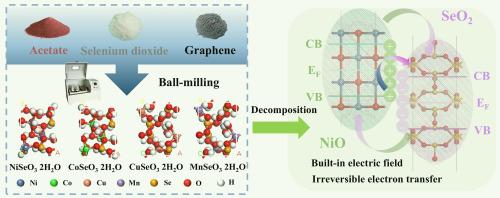Scalable mechanochemical synthesis of selenite (MSeO3, M for Ni, Co, Mn, Cu) anodes for high-performance lithium-ion batteries and their lithium storage mechanism
IF 8.9
2区 工程技术
Q1 ENERGY & FUELS
引用次数: 0
Abstract
Transition metal selenites (TMS) are considered effective anode materials for lithium-ion batteries (LIBs). However, their development has been limited by low production yields, high laboratory synthesis costs, and imperfect lithium storage mechanisms. Here, we present a simple, efficient, and scalable mechanochemical synthesis method for TMS (MSeO3, where M stands for Co, Ni, Cu, or Mn) for the first time. The optimized process produces MSeO3 with high lithium storage capacity (2459.6 mAh g−1 at 0.2 A g−1 for 400 cycles), remarkable high-current charge/discharge capability (15 A g−1), and excellent cycling stability (1500 and 1740 cycles at 5 and 10 A g−1, respectively) when used as a lithium anode. Cyclic voltammetry (CV), in-situ Raman spectroscopy, ex-situ transmission electron microscopy (TEM), and X-ray diffraction (XRD) confirmed the decomposition of TMS during the first lithiation to form metal oxide and selenium oxide heterostructures. The reduction product metal monomers were found to be involved in an irreversible alloying process, which leads to capacity decay in the initial stage, using dQ/dV and post X-ray photoelectron spectroscopy (XPS). Subsequently, selenium oxide dominates, leading to an increase in specific capacity. Density functional theory (DFT) calculations suggest that the mismatched band structure of these materials may cause the capacity fluctuations prevalent in TMS. This study paves the way for the large-scale production of selenite and sheds new light on the lithium storage mechanism in TMS.

高性能锂离子电池亚硒酸盐(MSeO3, M代表Ni, Co, Mn, Cu)阳极的可扩展机械化学合成及其储锂机理
过渡金属亚硒酸盐(TMS)被认为是锂离子电池(LIBs)的有效阳极材料。然而,它们的发展受到低产量、高实验室合成成本和不完善的锂储存机制的限制。在这里,我们首次提出了一种简单,高效,可扩展的TMS (MSeO3,其中M代表Co, Ni, Cu或Mn)的机械化学合成方法。优化后的工艺制备的MSeO3作为锂阳极具有较高的锂存储容量(在0.2 A g−1时2459.6 mAh g−1,循环400次),显著的大电流充放电能力(15 A g−1),以及优异的循环稳定性(分别在5和10 A g−1下循环1500次和1740次)。循环伏安法(CV)、原位拉曼光谱、非原位透射电镜(TEM)和x射线衍射(XRD)证实了TMS在第一次锂化过程中分解形成金属氧化物和氧化硒异质结构。利用dQ/dV和后x射线光电子能谱(XPS)分析发现,还原产物金属单体参与了一个不可逆的合金化过程,在初始阶段导致了容量衰减。随后,氧化硒占主导地位,导致比容量增加。密度泛函理论(DFT)计算表明,这些材料的不匹配带结构可能导致TMS中普遍存在的容量波动。该研究为亚硒酸盐的大规模生产铺平了道路,并为TMS中锂的储存机制提供了新的思路。
本文章由计算机程序翻译,如有差异,请以英文原文为准。
求助全文
约1分钟内获得全文
求助全文
来源期刊

Journal of energy storage
Energy-Renewable Energy, Sustainability and the Environment
CiteScore
11.80
自引率
24.50%
发文量
2262
审稿时长
69 days
期刊介绍:
Journal of energy storage focusses on all aspects of energy storage, in particular systems integration, electric grid integration, modelling and analysis, novel energy storage technologies, sizing and management strategies, business models for operation of storage systems and energy storage developments worldwide.
 求助内容:
求助内容: 应助结果提醒方式:
应助结果提醒方式:


